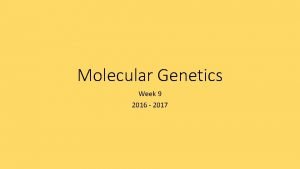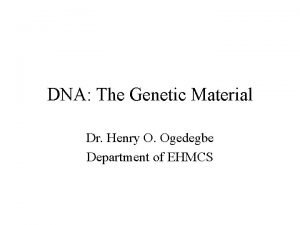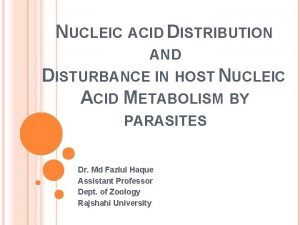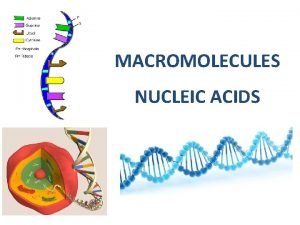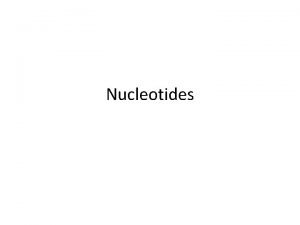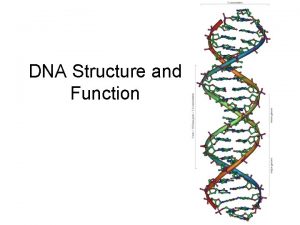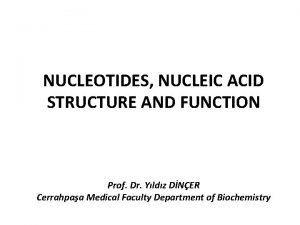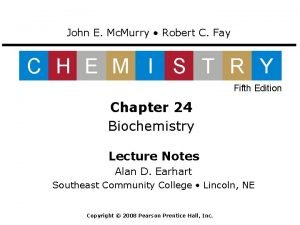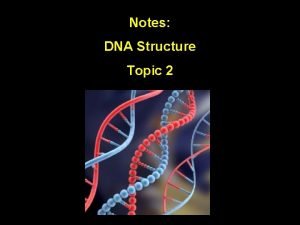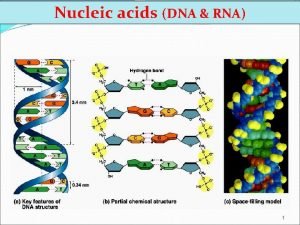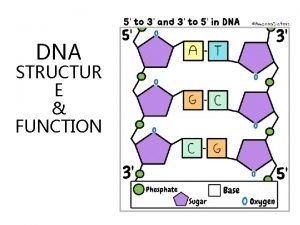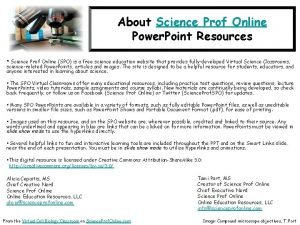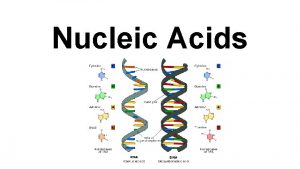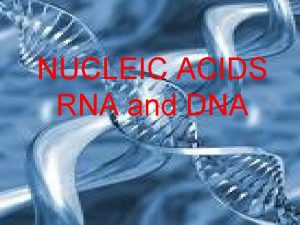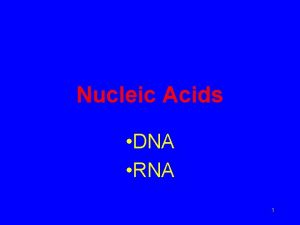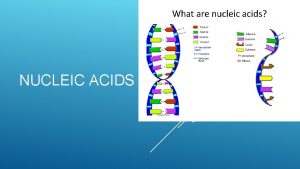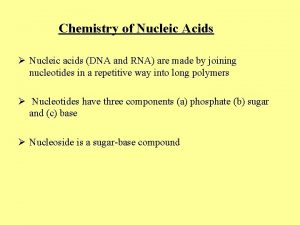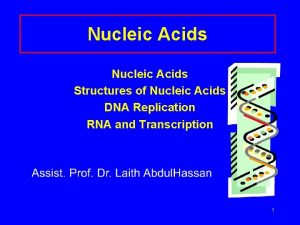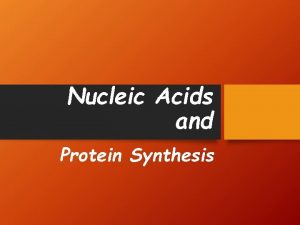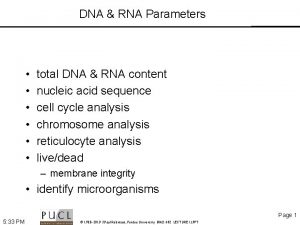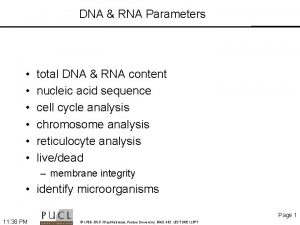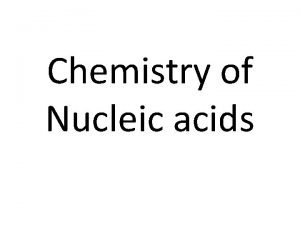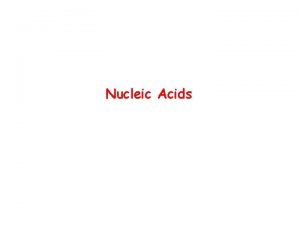Nucleic Acids DNA RNA How DNA Works 1


















- Slides: 18

Nucleic Acids DNA & RNA

How DNA Works 1 - DNA stores genetic information in segments called genes 2 - The DNA code is in Triplet Codons (short sequences of 3 nucleotides each) 3 - Certain codons are translated by the cell into certain Amino acids. 4. Thus, the sequence of nucleotides in DNA indicate a sequence of Amino acids in a protein.

Transcription Process • Several turns of the DNA double helix unwind, exposing the bases of the two strands • Ribonucleotides line up in the proper order by hydrogen bonding to their complementary bases on DNA • Bonds form in the 5 3 direction, Based on Mc. Murry, Organic Chemistry, Chapter 28, 6 th edition, (c) 2003 3

RNA—Ribonucleic Acid • RNA is a messenger that allows the instruction of DNA to be delivered to the rest of the cell • RNA is different than DNA: 1. The sugar in RNA is ribose; the sugar in DNA is deoxyribose 2. RNA is a single strand of nucleotides; DNA is a double strand of nucleotides 3. RNA has Uracil (U) instead of Thymine (T) which is in DNA 4. RNA is found inside and outside of the nucleus; DNA is found only inside the nucleus

Transcription of RNA from DNA • Only one of the two DNA strands is transcribed into m. RNA • The strand that contains the gene is the coding or sense strand • The strand that gets transcribed is the template or antisense strand • The RNA molecule produced during transcription is a copy of the coding strand (with U in place of T)

Example of RNA Primary Structure • In RNA, A, C, G, and U are linked by 3’-5’ ester bonds between ribose and phosphate

The Parts of Transfer RNA • There are 61 different t. RNAs, one for each of the 61 codons that specifies an amino acid • t. RNA has 70 -100 ribonucleotides and is bonded to a specific amino acid by an ester linkage through the 3 hydroxyl on ribose at the 3 end of the t. RNA • Each t. RNA has a segment called an anticodon, a sequence of three ribonucleotides complementary to the codon sequence

Protein Synthesis • The two main processes involved in protein synthesis are - the formation of m. RNA from DNA (transcription) - the conversion by t. RNA to protein at the ribosome (translation) • Transcription takes place in the nucleus, while translation takes place in the cytoplasm • Genetic information is transcribed to form m. RNA much the same way it is replicated during cell division

RNA Polymerase • During transcription, RNA polymerase moves along the DNA template in the 3’-5’direction to synthesize the corresponding m. RNA • The m. RNA is released at the termination point

Processing of m. RNA • Genes in the DNA of eukaryotes contain exons that code for proteins along with introns that do not • Because the initial m. RNA, called a pre-RNA, includes the noncoding introns, it must be processed before it can be read by the t. RNA • While the m. RNA is still in the nucleus, the introns are removed from the pre-RNA • The exons that remain are joined to form the m. RNA that leaves the nucleus with the information for the synthesis of protein

Removing Introns from m. RNA




Transcription • Several steps occur during transcription: - a section of DNA containing the gene unwinds - one strand of DNA is copied starting at the initiation point, which has the sequence TATAAA - an m. RNA is synthesized using complementary base pairing with uracil (U) replacing thymine (T) - the newly formed m. RNA moves out of the nucleus to ribosomes in the cytoplasm and the DNA re-winds

The Structure of t. RNA


Regulation of Transcription • A specific m. RNA is synthesized when the cell requires a particular protein • The synthesis is regulated at the transcription level: - feedback control, where the end products speed up or slow the synthesis of m. RNA - enzyme induction, where a high level of a reactant induces the transcription process to provide the necessary enzymes for that reactant • Regulation of transcription in eukaryotes is complicated and we will not study it here
 Dna rna protein synthesis homework #2 dna replication
Dna rna protein synthesis homework #2 dna replication Stores and transmits genetic (hereditary) information
Stores and transmits genetic (hereditary) information Nucleic acids concept map
Nucleic acids concept map Features of nucleic acid
Features of nucleic acid Dna nucleotide
Dna nucleotide Function of nucleic acids
Function of nucleic acids The building block of nucleic acid
The building block of nucleic acid Nucleotide nomenclature
Nucleotide nomenclature Biomedical importance of nucleotides
Biomedical importance of nucleotides Food sources of nucleic acids
Food sources of nucleic acids Polymer structure of nucleic acids
Polymer structure of nucleic acids Nucleotide function
Nucleotide function Hydoxyle
Hydoxyle Nucleic acids
Nucleic acids Function of nucleic acid
Function of nucleic acid Nucleic acid structure
Nucleic acid structure Nucleic acid dna structure
Nucleic acid dna structure Nucleic acid dna structure
Nucleic acid dna structure Nucleic acid dna structure
Nucleic acid dna structure


